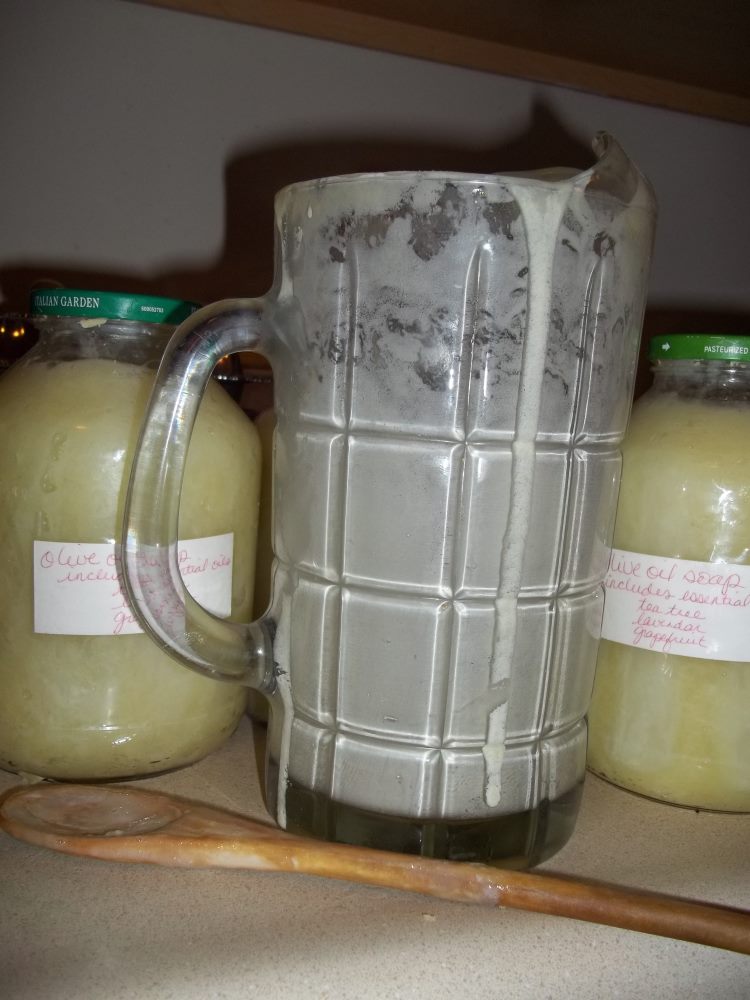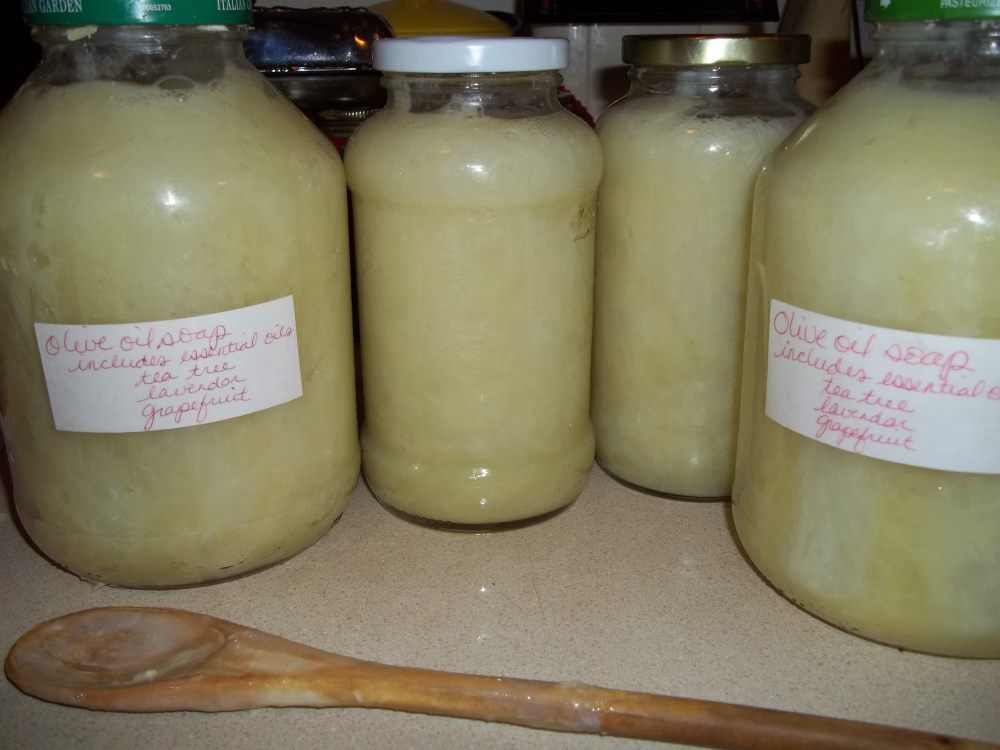There are so many sites out there in the internet-world describing how to make liquid soap - and most of them can be described in one word:
COMPLICATED.
Seriously? The same bar soap just liquified needs to be THAT hard?
I think not.
The problems with what is out there:
1) store-bought bar soaps (and many soaps bought online, but not all) have the glycerin removed during the soap-making process. Therefore glycerin needs to be added back in to the soap to help it "be" liquid.
2) Alcohol and other additives can be DRYING. These are not necessary - neither for preservation (most liquid soap keeps itself preserved, or one can use particular essential oils for preservation - vitamin E is great too) nor for any other reason (I had a second reason but have now forgotten it).
3) Starting with liquid soap kind of defeats the purpose. Seriously.
4) Dr. Bronner's Castille soap is great - but a little secret: castille soap is simply olive oil soap. Guess what!? You can make that at home.
5) The ones that do provide a recipe from scratch, want you to use a different form of lye - Sodium Hydroxide (NaOH) instead of what is typically used in bar soaps: Potassium Hydroxide (KOH). I do NOT understand this. I have put out some requests and have heard no responses. If YOU know why, please respond, because I genuinely want to know the reason why a different form of lye would be needed for liquid soap.
Now. Why would you want to start with bar soap (that was liquid during the soapmaking process to begin with) and liquify it? Because not everyone can have lye around. It's dangerous stuff with little ones or if you don't have the greatest coordination. I think I'm pretty decent and I've had a couple of minor incidents with yellowed curling finger nails and one spot on my arm. All is well now, but it was pretty scary (and stinky). If you cannot have lye in your home, purchase a "full body bar soap" - this is MY terminology alone, not an official label. What you are looking for is a simple, all-natural soap containing ONLY the ingredients YOU want (you can add more if you want during the process, but make sure there is nothing in there you DON'T want) - and make sure the glycerin has not been removed (this is what I call "full body" - it's all the soap, nothing removed). Grate it up into a saucepan and add twice as much water as the amount of soap you have. Bring to a gentle simmer and stir almost constantly until the soap has melted - add any additional ingredients you want. Allow to cool - if it gets too thick, warm it back up and add water about 1/2 to a full cup at a time (you can gauge the amounts based on the thickness - very thick, add more water; getting close to what you want add less at a time), stirring and cooling until it gets to the thickness you like. After a time or two making it like this, you'll recognize the thickness it needs to be when "hot" to be the consistency you want when "cool". This is how I always used to make our soap.
So how do *I* make liquid soap now?
[caption id="" align="alignnone" width="270"]
 Those of you who visit my home and recognize the pitcher: Rest assured I do watch it. Remember that my alternate dish soap is this SAME soap plus coconut oil soap. It's JUST soap ;)[/caption]
Those of you who visit my home and recognize the pitcher: Rest assured I do watch it. Remember that my alternate dish soap is this SAME soap plus coconut oil soap. It's JUST soap ;)[/caption][caption id="" align="alignnone" width="360"]
 I had 2 more of the "smaller" jars as well. From that one pitcher of soap!!![/caption]
I had 2 more of the "smaller" jars as well. From that one pitcher of soap!!![/caption]Start with making olive oil soap, adding the highest amount of the required range of water. When any soap is made, a typical lye calculator will give a range of water amounts to use - use less if you want to set up faster; more if you want it to set up slower. Olive oil soap takes a while to set up anyway, so I typically use on the lower end if I am making bar soaps. For a recipe of 32 ounces of olive oil, I need 4.2 oz of Sodium Hydroxide (lye) and 8-12 ounces of water. I made a recipe last week with 15 ounces of water (I didn't want to over-do it because I did want the oil and lye to be close enough to saponify well. This all perfectly fit into my beautiful glass pitcher.
I used a stick blender to bring it to trace, but I used to wait and stir and wait and stir - sometimes up to a full day to get the olive oil soap to trace. I LOVE stick blenders ;)
Then I separated it into two large old spaghetti sauce jars, filling each about half. I filled the rest with water and stirred. Added essential oils (in this case I used lavender, tea tree oil and grapefruit essential oils as well as vitamin E - to personal scent-preference). Let it sit. Stirred the next morning - it was THICK. Poured some out into 2 other jars and filled up with water again. Within 12 hours: thick again.
Poured into 2 more of the smaller jars and some into our current soap dispenser, adding more water to bring it to consistency in the dispenser.
The stuff in the glass jars is still thick though very close to the consistency I want and I will thin it as we use it.
That is a LOT of soap - for almost NO work. Next time, I'll stick with 16 ounces and I'll probably fill up this same amount of jars with soap at the proper consistency.
I didn't use any of the complicated process (one site says you can't make liquid soap using cold-process soap-making - ummmm, this is my second time making liquid soap from scratch and the ONLY way I like to make soap is the cold-process version. I abhor heating it up and dealing with the curds - I do it only when absolutely necessary - and liquid soap-making from scratch works just fine in cold-process, thank you very much).
I don't do any of the other more complicated steps, because frankly - this method WORKS - we are getting ourselves clean - it is simply liquified versions of my bar soaps - so why would I go to more trouble for a liquid than I do for the bars?
Lazy Mom syndrome again ;)
Or maybe I just want to spend time with my son....
;)
No comments:
Post a Comment